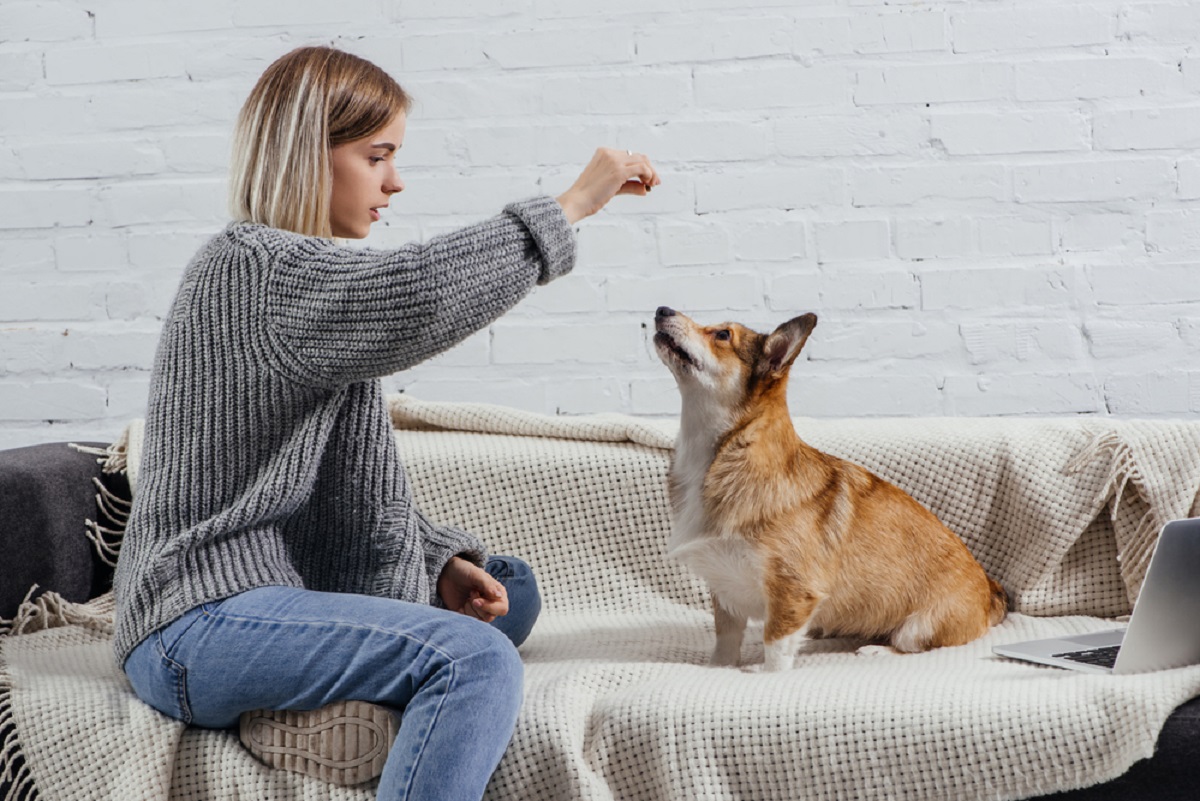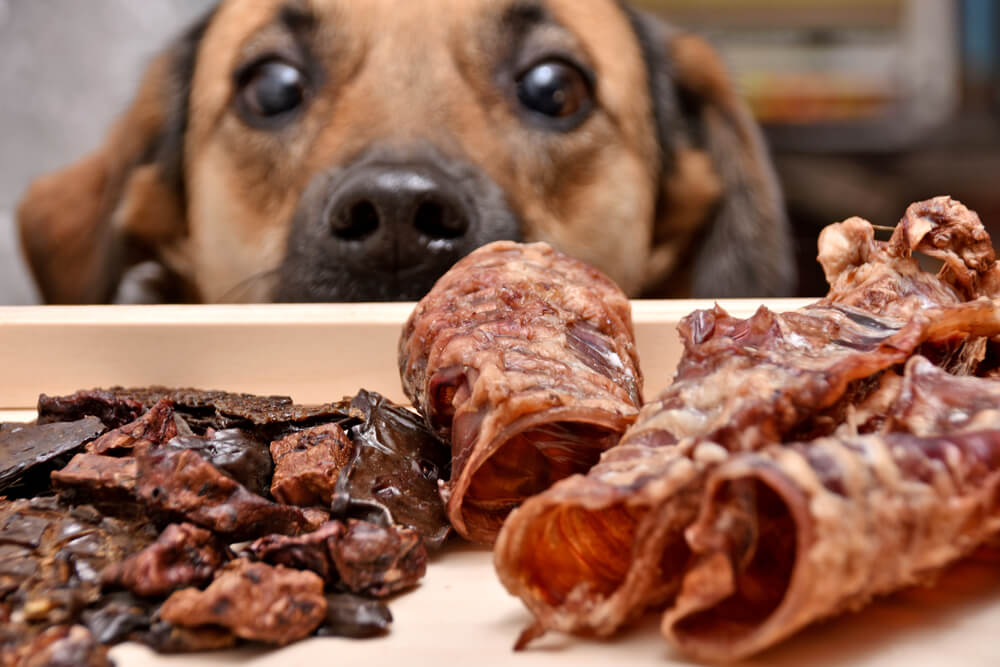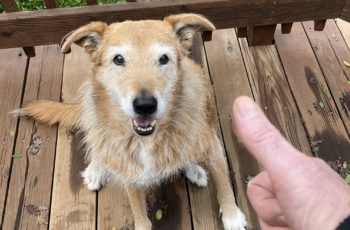No matter if you are watching a dog owner or a professional dog trainer train a dog, you have likely seen them use treats.
Treats are an essential part of dog training using positive reinforcement. There is a very good reason for that. Food is a huge motivator for most dogs. This makes them an essential currency when teaching them new things and changing their behavior.
In this article, I’ll be sharing everything dog owners need to know about training their dogs using treats.
Let’s get into it!

Are Training Treats Good For Dogs?
The answer to this question depends entirely on the type of treat that you are using. Most of the time training treats bought from the store are not necessarily the healthiest option. This is because companies want these treats to taste good to the dog, making them a better reward.
A great way to get around this problem is by breaking these treats up.
Even just pea-sized pieces of treats are rewarding to dogs. Breaking treats up into small pieces will prevent you from feeding your dog 50 treats in a training session. Really, you will be giving them 50 pieces of a treat, which usually ends up being just a few whole treats in reality.
Still, if you are worried about your dog putting on a few pounds there are healthier options. Pieces of carrots, tastes of canned pumpkin, and pieces of boiled chicken can be great rewards that are lower in calories.
Treat Training Vs. Non-Treat Training: Which is Better?
Research shows that the best dog training methods are those that use positive reinforcement. This is especially true for basic obedience training.
While treats are usually the easiest form of positive reinforcement, toys and praise are also common rewards for dogs. Treats are usually just the easiest way to give dogs a super high reward quickly.
It can seem like we are bribing our pets with treats during training sessions. However, this is just the best way to keep our pets motivated when teaching them something new. Over time you will be able to phase out using treats and rely on praise as the primary reward.
High-Value Vs. Low-Value Reward: What’s the Difference?
In positive reinforcement training, there are two types of rewards.
These are high-value and low-value rewards. A high-value reward is something that your dog loves. For most dogs, high-value rewards include very tasty treats like meats and pieces of cheese.

Meanwhile, a low-value reward is something that your dog likes, but it isn’t going to motivate them as much as the high-value reward would. A good example of a low-value reward is dry kibble. Even though many dogs like their kibble, it is not as good as a piece of hot dog.
Easy and Healthy Dog Training Treat Ideas
There are many different things that you can use as a treat for your dog.
Here are three different routes that you could take when choosing training treats.
Pantry Ingredients That Make Great Training Treats
Many pantry ingredients are safe for dogs to eat, and they make great treats as well.
For example, boiled chicken without any seasonings can be a great high-value reward for most dogs.
Here are some other foods that can make for great dog treats:
- Canned pumpkin (make sure there are no seasonings or sugar.)
- Cooked sweet potato (no seasoning or butter)
- Small Pieces of Cheese (high calorie, use sparingly)
- Carrots
- Apples and pears (no seeds)
- Peanut butter (high calorie, use sparingly)
- Pieces of lean meats (make sure there are no seasonings and that the meats are low fat)
- Blueberries
- Watermelon
- Cooked peas
- Cooked green beans
Any of the above items could make for an excellent dog treat. Better yet, most of us have at least one of these things on hand. It is still important to remember if your dog has any food sensitivities or allergies when feeding them pantry ingredients.
Good Quality Training Treats to Buy From the Store
Of course, you could also always just purchase training treats from the store. Here are some of my dog’s favorite treats:
All of the above treats are very high quality and would make a great choice. However, any treat that your dog likes and digests well is great as well!
Amazing Homemade Training Treat Recipes
There are also many homemade dog treat recipes. This method of making dog treats is growing in popularity.
Check out these super fun and simple homemade dog treat recipe ideas, and I can almost guarantee your dog will love them.
Mouthwatering Liver Treats for Dogs
Liver is an excellent treat for dogs because it is both tasty and nutritious. Here is a great homemade recipe for liver dog treats.
- 1 lb of chicken livers (undrained)
- 2 eggs
- 16 oz of Jiffy corn muffin mix
- Preheat oven to 350 degrees.
- Blend eggs and chicken livers in a blender until smooth and fully combined.
- Mix liver and egg mixture into corn muffin mix. Stir until well combined.
- Cover a jelly roll pan or baking sheet with parchment paper or wax paper. Spread mixture onto the pan.
- Bake for 35 minutes or until firm.
Adapted from Treats, Play, Love by Patricia Gail Burnham, St. Martin’s Griffin, 2008.
Delicious Sweet Potato Biscuits
Many dogs love the taste of sweet potatoes.

Here is a great, healthy dog biscuit recipe that will fulfill your dog’s sweet potato craving, adapted from My Baking Addiction.
- 1 cup pure, canned sweet potato
- 1 egg (beaten)
- 1 ¾ cups of whole wheat flour, brown rice flour, or gluten-free flour
- Preheat oven to 350 degrees.
- Blend ingredients until the dough is firm.
- Cover a cookie sheet with parchment paper or wax paper.
- Roll dough into small balls. Place on a cookie sheet with some space in between.
- Lightly press down so the biscuits will be about ¼ of an inch thick.
- Bake for 30 minutes or until golden brown.
How Many Training Treats Can You Give a Puppy in a Day?
The answer to this question can be pretty complicated.
This is because it involves calculating how many calories a puppy needs in a day. You will also need to know how many calories are in each treat, and how much of your puppy’s diet should be treats.

To keep things simple it is a good idea to give a puppy two average-sized treats maximum.
Breaking these treats up into many small pieces will help stretch the ration out. This will allow you to use treats for training without risking your puppy’s health. If the treat is large just use one.
When Should I Stop Giving my Dog Training Treats?
Once your dog is responding to a command 90-100% of the time, you can stop giving them treats every time.
This is because when a command is at this stage in the learning process dogs will respond well to just receiving praise. This is called phasing out treats.
How to Phase Out Training Treats
Phasing out treats is a lot simpler than it may seem. Once your dog is responding to a command consistently, you can start the treat phasing process.
Here is how you can phase out treats.
Step 1: Have your dog respond to a command consistently.
Step 2: Start only giving a treat reward for excellent execution of that command. Some examples of this are:
- The dog listens to the command very quickly.
- The dog does the command in a high-distraction area.
- The dog followed the command better than they have in the past.
Step 3: Raise the standards for when you give a treat as your dog gets better at it.
Step 4: Continue raising your expectations for a treat reward until your dog will do the command anywhere without one.


